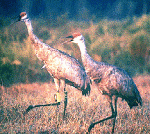Mississippi Sandhill Crane
Scientific Name: Grus canadensis pulla | Current Range: Mississippi (U.S.)
Mississippi sandhill cranes resemble great blue herons (Ardea herodias). A major distinguishing characteristic is that cranes are completely gray. Great blue herons usually have white on their heads and dark colored underparts. When standing erect, cranes are about 4 feet tall. Male and female cranes are similar in appearance. All cranes have long necks, and adult cranes possess a bald red forehead. The species vocalizations are loud and clattering. Cranes are also unique in that they require separate nesting, foraging, and roosting habitats.
Crane feeding habits vary with the seasons. In the summer, the birds feed upon the natural foods found in swamps, savannas, and open forests. These include adult and larval insects, earthworms, crayfish, small reptiles, frogs and other amphibians, and possibly small birds and mammals. Cranes also consume roots, tubers, nuts, seeds, fruits, and leaves. During the other three seasons, the birds eat small corn and chufa, an introduced plant. In the early fall, cranes usually feed on corn until the kernals become scarce. Chufa is used year round. Pecans are often eaten from September through December.
Although some nesting occurs in forested areas, most takes place in open savannas and swamp openings. These areas vary from dry to being covered in shallow water. Nests are constructed on the ground of vegetation gathered in the immediate vacinity.
Paired cranes select a breeding territory for courtship, mating, and nesting, and may defend it from other cranes. Territory size probably depends on the quality and type of the habitat, the age of the paired cranes, and the population density of other cranes. Only one pair of birds has been observed to nest during a season in each open savanna; but, where clearings are separated by forested areas, cranes have nested within one-half mile of each other. Nesting territories are generally used for more than 1 year, some for 10 to 17 years. Cranes also tend to reuse nests for up to 3 consecutive years. When new nests are constructed, they are often located close to the previous nests.
The age of sexual maturity for the Mississippi sandhill is thought to be 3 or 4 years of age. There is a theory that the species productivity has been low.
Savannas are the preferred habitat of the Mississippi sandhill crane and are inhabited year round. These wet grasslands are predominated by wiregrass (Aristida spp.) with scattered longleaf pine (Pinus palustris), slash pine (P. elliottii), and cypress (Taxodium ascendens) trees. Other associated plants include pitcher plants (Sarracenia spp.), sundew (Drosera spp), clubmoss (Lycopodium alopecuroides), and pipeworts (Eriocaulon spp.). Cranes also utilize wooded depressions (swamps or ponds) dominated by cypress, longleaf, and slash pine trees with an understory of swamp cyrilla (Cyrilla racemiflora), buckwheat tree Cliftonia monophylla), wax myrtle (Myrica cerifera), and several species of holly (Ilex spp.)

Cause of decline...
With population estimates of less than 100 birds since 1929, the Mississippi sandhill crane's status has always been precarious. During the 1950's thousands of acres of the crane's favored savanna habitat were drained and converted to slash pine plantations. Dense understories developed underneath the mature pine trees, and the once open, undisturbed habitat became unsuitable for cranes. Commercial and residential development also progressed, and the human population increased. Eight paved highways now transect or border the crane's range. These roads have further depleted habitat, caused pollution problems, and eased public access to the cranes. Sporadic crane shootings were reported in the 1960's and 1970's. In addition, roadsides are usually sprayed with herbicides or other pollutants. Until recently, fire ants were eliminated with Mirex. A dead crane was discovered in 1974 with Mirex residues in the breast muscle and brain.
Five of the cranes necropsied by the Patuxent Wildlife Research Center since 1981 have had tumors. Suspected causes have been infectious viruses or parasites, naturally occurring toxins, and genetic predisposition. The crane's susceptibility to tumors may have resulted from a decrease in genetic variability. Low genetic variability may also be responsible for a decrease in hatching success, and for deformities in the captive population. Natural causes, such as flash floods, hurricanes, and droughts, have also caused some deaths.

